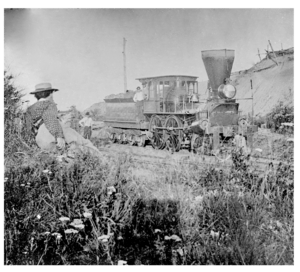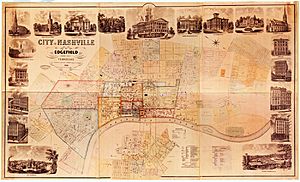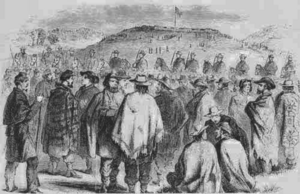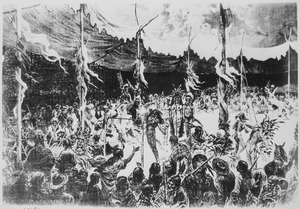John A. Haydon facts for kids
Quick facts for kids
John A. Haydon
|
|
|---|---|
| Born | June 21, 1830 Alexandria, Virginia, United States
|
| Died | September 26, 1902 (aged 72) Frederick, Maryland, United States
|
| Occupation | surveyor, civil engineer, Railroad executive |
John A. Haydon (1830 – 1902) was an important American surveyor and civil engineer. He taught himself civil engineering and helped build many railroads in the United States. His work included expanding the Baltimore and Ohio Railroad and working on the Northern Pacific Railway.
In 1872, Haydon led an expedition along the Yellowstone River. During this trip, his group faced a skirmish with Sioux and Cheyenne warriors led by famous chiefs like Sitting Bull and Crazy Horse.
During the American Civil War, Haydon was a captain in the Confederate Army. He was captured early in the war but later released. After the war, he continued to work on railroads, helping to plan new routes.
Early Life and Railroad Work
John A. Haydon was born on June 21, 1830, in Alexandria, Virginia. We don't know much about his early schooling or first jobs. He married Alice M. McSherry in 1872, and they had five children who survived.
Building Railroads Across the Country
In 1850, Haydon joined the engineering team for the Baltimore and Ohio Railroad. They were working to extend the railroad further west.
Two years later, in 1852, he worked on the Orange and Alexandria Railroad. He helped build the middle section of this railway.
By 1854, Haydon was a resident engineer for the Louisville and Nashville Railroad. He worked on a difficult section in Tennessee. This part of the railroad included two tunnels and many deep cuts through rock. The railroad was completed into Nashville in 1859.
In 1860, Haydon worked as the city engineer for Nashville, Tennessee.
Service During the Civil War
When the American Civil War began in 1861, Haydon became a captain in the Confederate Army. He was assigned to Fort Henry in Tennessee.
Fort Henry and Capture
Haydon helped build and improve the defenses at Fort Henry. The work was slow because of a lack of workers and supplies. In February 1862, the fort was attacked and surrendered. Haydon was captured during the Battle of Fort Henry.
He was sent to Johnson's Island in Ohio. This was a prison camp specifically for Confederate officers. Haydon was released in November 1862.
Engineer for the Confederacy
After his release, Haydon worked for the Confederate Engineer Bureau. He helped rebuild bridges and scouted areas near the Potomac River. He also helped remove railroad tracks in East Tennessee during a military campaign. In 1864, he worked on defending Charleston, South Carolina.
In April 1865, Haydon was released a second time. This happened when General Joseph E. Johnston's army surrendered in North Carolina.
After the War
After the Civil War, Haydon continued his engineering career. In 1866, he became chief engineer for a canal company in South Carolina. This company planned to bring fresh water to the city of Charleston. He also worked for the Greenville and Columbia Railroad.
Frederick and Pennsylvania Line Railroad
In 1868, Haydon became the chief engineer for the Frederick and Pennsylvania Line Railroad in Maryland. He finished building this railroad in June 1872.
Northern Pacific Railway Expedition
In the early 1870s, the Northern Pacific Railway was trying to find the best route for its tracks across the western United States. A large section of the route in Montana and Dakota was still unknown.
In 1872, John Haydon was hired to lead a survey party. His mission was to map a route along the Yellowstone River. His team included 20 men and was protected by a military escort of 376 soldiers. They had many wagons with supplies for over three months.
Battle of Pryor's Creek
On August 13, 1872, a large group of Lakota, Cheyenne, and other Native American warriors gathered. They were led by chiefs like Sitting Bull and Crazy Horse. The next day, August 14, Sitting Bull's warriors attacked Haydon's survey party near Pryor's Creek in Montana.
The battle lasted for several hours. Amazingly, no one in Haydon's group was hurt. Sitting Bull himself showed great bravery during the fight. After the battle, Haydon realized his group was likely outnumbered. He decided to turn back to Fort Ellis for safety. This event was a setback for the Northern Pacific Railroad's plans.
Returning to Fort Ellis
On August 20, 1872, Haydon's party left the Yellowstone River. They marched towards the Musselshell River. Haydon became ill during the journey, but he soon recovered and continued leading the group. They faced snow and cold weather. On September 26, Haydon reached the Northern Pacific Railway's offices in Helena, ending the expedition.
Later Railroad Work
In 1873, the Baltimore and Ohio Railroad gained control over coal exports from the Georges Creek Valley in Maryland. To avoid this control, local interests formed the Pennsylvania railroad in Maryland. In 1878, Haydon became its Chief Engineer. Construction began in 1879, and the railroad started passenger service later that year.
In 1880, Haydon also helped form the Central Railway Company of Baltimore. This company aimed to compete with existing streetcar lines in the city.
Inventions and Death
John Haydon received two patents for his inventions:
- In 1881, he patented a device for feeding animals in a stock car.
- In 1876, he patented a new type of roadway pavement. This pavement had layers of stone, concrete, and a top dressing.
John A. Haydon died in Frederick, Maryland, on September 26, 1902. He is buried in St. John's Cemetery.








